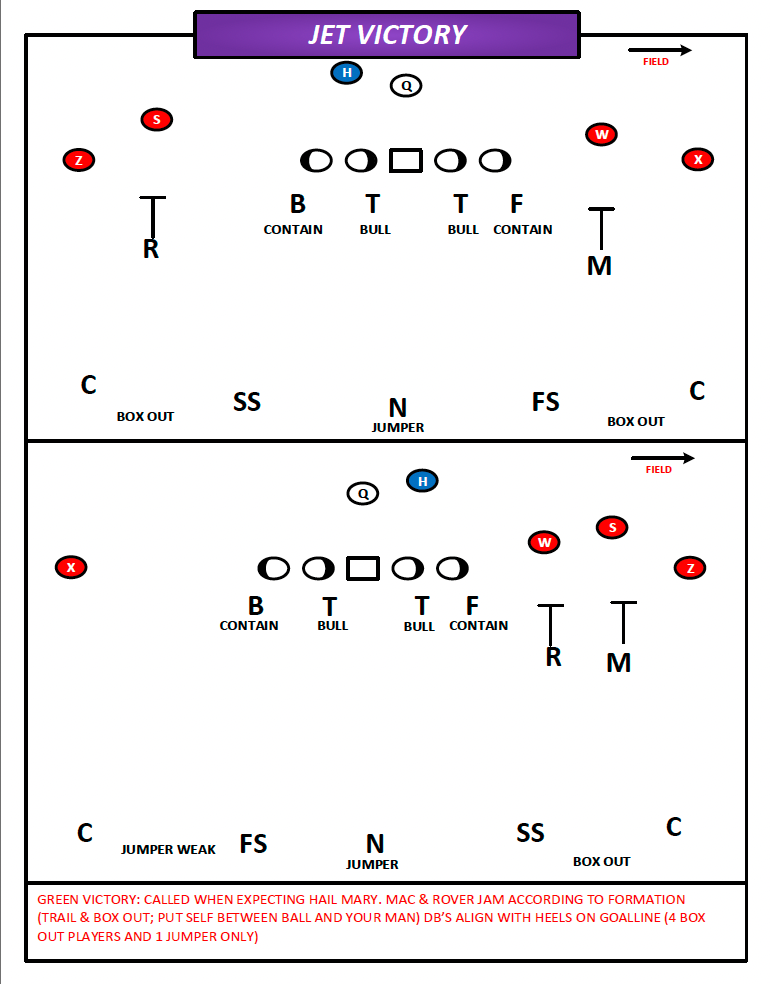One of the bigger stories from the weekend, or at least a highlight shown on repeat, was Colorado’s miraculous Hail Mary completion against Baylor to force overtime. I didn’t catch the game live, but it immediately got me thinking about how teams prepare to defend against that exact situation. More importantly, how often do coaches actually practice this scenario?
The first question when defending a Hail Mary becomes how you want to rush the quarterback. Do you rush 3, 4, 5, 6, or even 7 defenders? More pressure could disrupt the timing, but dropping more players into coverage gives you better odds in the inevitable jump ball situation. Once you settle on the rush, the next consideration is what coverage to run. Do you play man-to-man, or drop into a zone and try to overwhelm the offense with numbers? And then there’s the matter of personnel—do they have a player you need to double?
Lastly, how much practice time do you devote to preparing for a Hail Mary, knowing it’s something you might not see once all year? Balancing time between game plans and rare situations like this is always a coaching challenge.
Hail Mary on Saturday
Every coach at the collegiate and professional level likely has a few different strategies for defending a Hail Mary. It’s one of those situations where the margin for error is slim, but the number of approaches is wide-ranging. From rushing three and flooding the end zone with defensive backs, to sending extra pressure and trusting your athletes in man coverage, there’s no shortage of options.
When he was at LSU, one of Dave Aranda’s defenses for the Hail Mary was particularly interesting. Aranda, known for his methodical and innovative defensive schemes, approached the situation with a disciplined yet aggressive mindset. If the diagram below, he’d often keep five players deep, while man matching the slot receivers underneath.
If we applied that approach to the Baylor vs. Colorado game, Baylor likely would’ve had multiple defenders ready for the deep throw along the sideline. By keeping more players back and avoiding press man coverage, the chance of a defensive back slipping or getting beaten cleanly would’ve been much smaller. The defense could’ve been in a better position to prevent the catch, or at the very least, force a more contested play on the ball.
Of course, hindsight is always 20/20. So, let’s break down what actually happened in the play.
The first breakdown on this play for the Baylor defense starts with the field backer, who inexplicably rushes inside on the full slide protection. This allows Colorado’s quarterback, Shedeur Sanders, to escape the pocket and make the throw. Had the backer rushed outside, he would’ve either kept Sanders in the pocket or forced him to make the throw without the benefit of forward momentum—drastically reducing the likelihood of a successful pass.
The next breakdown occurs in the coverage, specifically with the two deep safeties. Travis Hunter, lined up as the single receiver on the opposite side of the trips formation, runs a route with a departure angle that clearly indicates the Hail Mary is designed to go to the other side of the field. This visual cue should have triggered the safeties to shift their attention toward the trips set. Unfortunately, the safety responsible for the side of the throw hesitates and hangs on the hash a little too long, despite knowing he has inside help from the other safety.
Finally, in the moment of truth, the safety makes a critical error by going for the ball instead of simply burying the receiver. At worst, a 15-yard penalty would have been preferable to allowing the completion that ultimately forced overtime.
Hail Mary on Sunday
Interestingly enough, another Hail Mary situation unfolded the very next day in the NFL, except this time it happened just before halftime. In the pros, defending a Hail Mary can be just as tricky, especially when teams are trying to prevent a quick score before heading to the locker room. While the stakes might not have been as high as Baylor vs. Colorado, the approach and execution remain crucial.
This Hail Mary, unlike the one between Baylor and Colorado, played out more like a traditional one. The ball was thrown to the trips side, there was a tip, and a trailing receiver caught it—almost perfectly executed by the offense.
On defense, the Colts decided to “rush four,” but in reality, it was more like two, as the other two defenders stayed back in case Caleb Williams broke the pocket. This allowed them to contain him and make Caleb throw the ball from inside the pocket. The safeties did a much better job in this situation, flooding to the trips side where the ball was targeted.
#32, Julian Blackmon, deserves special mention for his role in the play. He did an excellent job tracking the trailing receiver and, crucially, tackling him immediately after the catch, just before the goal line, preventing a potentially game-changing touchdown. While the offense almost executed the Hail Mary to perfection, the defense did enough to save the Colts from disaster.
Conclusion
In the game of football, it’s all about situations, and the Hail Mary is just another one coaches need to be ready for on both sides of the ball. The challenge lies in balancing how much time you dedicate to preparing for this scenario versus more frequent game situations. And while you might go multiple seasons without facing a Hail Mary, it’s inevitable that at some point you will. When that moment comes, you’ll be glad your players are prepared and know exactly what to do when the ball is in the air and the game is on the line.








